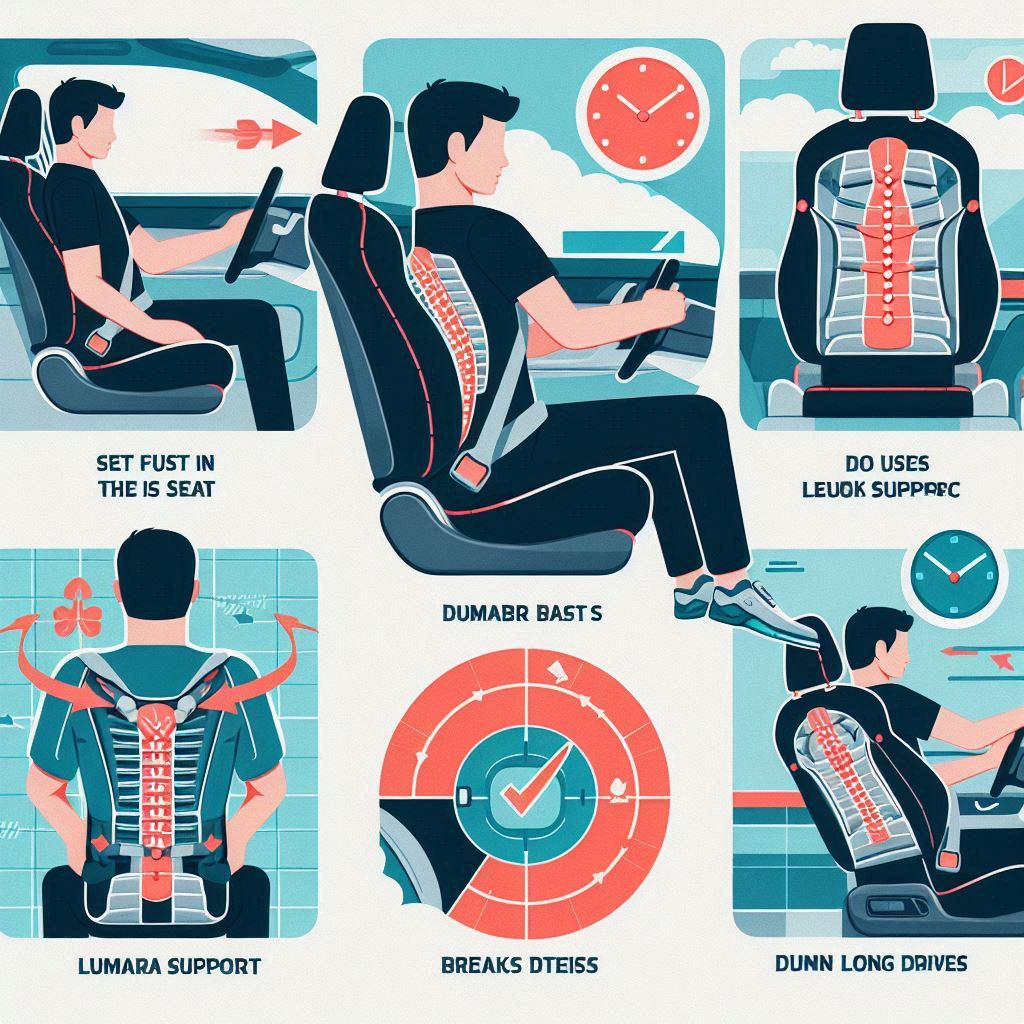Driving is an everyday activity for many people, but it can take a toll on your back if you’re not mindful. Whether you’re on a short commute or a long road trip, maintaining proper back health while driving is crucial to prevent discomfort and long-term injury. In this comprehensive guide, we’ll explore practical strategies to ensure your back stays healthy and pain-free during your time behind the wheel.
Understanding the Risks
Before diving into prevention techniques, it’s important to understand why driving can be detrimental to your back health. Extended periods of sitting, poor posture, and inadequate support can contribute to various back issues:
- Muscle Strain: Prolonged sitting in a fixed position can strain the muscles and ligaments in your back.
- Spinal Disc Pressure: Poor posture and lack of movement increase pressure on the spinal discs, potentially leading to herniation or bulging.
- Reduced Circulation: Sitting for long periods can impede blood flow, leading to stiffness and discomfort.
- Postural Imbalances: Incorrect seat positioning can cause uneven weight distribution, contributing to imbalances and pain.
Ergonomic Seat Adjustment
Proper seat adjustment is fundamental to maintaining a healthy back while driving. Here’s how to optimize your seat setup:
- Adjust Seat Height: Your seat should be adjusted so that your hips are level with or slightly higher than your knees. This promotes a more natural spinal alignment and reduces pressure on your lower back.
- Backrest Angle: Tilt the backrest so that it supports the natural curve of your spine. A slight recline (15-30 degrees) is usually ideal. Avoid reclining too much, as this can strain your lower back and make it harder to reach the pedals comfortably.
- Lumbar Support: Use the built-in lumbar support to support the curve of your lower back. If your vehicle doesn’t have adjustable lumbar support, consider investing in an aftermarket lumbar cushion.
- Seat Position: Adjust the seat so that you can easily reach the pedals with your legs slightly bent. Your elbows should be slightly bent when gripping the steering wheel. This position minimizes strain on your back and shoulders.
Posture and Positioning
Maintaining good posture while driving is essential for back health. Here’s how to ensure you’re sitting correctly:
- Sit Back in Your Seat: Your buttocks should be fully in contact with the back of the seat. This provides better support and prevents slouching.
- Keep Your Feet Flat: Your feet should rest flat on the floor or the footrest, with your knees at a right angle. This helps maintain proper posture and reduces lower back strain.
- Avoid Slouching: Sit up straight with your shoulders relaxed and your head aligned with your spine. Slouching or leaning forward can put additional stress on your back muscles and spinal discs.
- Use a Cushion or Lumbar Roll: If your vehicle’s seat doesn’t offer sufficient support, use a cushion or lumbar roll to maintain the natural curve of your spine.
Taking Breaks and Moving
Sitting for prolonged periods is a major risk factor for back pain. Incorporating movement and taking regular breaks can help alleviate discomfort:
- Schedule Breaks: On long drives, take a break every 1-2 hours. Use this time to stretch and walk around to relieve muscle tension and improve circulation.
- Stretching Exercises: Perform gentle stretches to relieve back tension. Some effective stretches include:
- Seated Forward Bend: While seated, lean forward and reach towards your toes to stretch your lower back.
- Torso Twist: While seated, twist your torso gently to each side to stretch your back and hips.
- Neck Stretches: Tilt your head towards each shoulder to relieve tension in your neck and upper back.
- Strengthening Exercises: Regularly perform exercises to strengthen your core muscles, which support your back. Examples include:
- Planks: Hold a plank position to engage your core muscles.
- Bridges: Lift your hips while lying on your back to strengthen your lower back and glutes.
- Bird-Dog: On all fours, extend one arm and the opposite leg to improve stability and strength.
Using Supportive Accessories
Several accessories can help enhance your driving experience and protect your back:
- Seat Cushions: Memory foam or gel seat cushions can provide additional support and comfort, especially for long drives. They help distribute pressure more evenly and reduce discomfort.
- Backrest Cushions: Backrest cushions or lumbar rolls support the natural curve of your spine, promoting better posture and reducing strain.
- Steering Wheel Covers: Ergonomic steering wheel covers can provide a more comfortable grip and reduce the strain on your wrists and shoulders, which can indirectly benefit your back.
- Adjustable Pedals: If your vehicle has adjustable pedals, set them to a position that allows for a more natural leg position. This adjustment can reduce the strain on your lower back.
Driving Habits and Techniques
How you drive can also impact your back health. Adopting good driving habits can make a significant difference:
- Use Cruise Control: On long drives, use cruise control to minimize the need for frequent pedal adjustments. This can help reduce muscle tension and fatigue.
- Maintain a Relaxed Grip: Hold the steering wheel with a relaxed grip to avoid unnecessary tension in your shoulders and arms.
- Adjust Your Mirrors: Ensure your mirrors are properly adjusted to reduce the need for awkward head and neck movements. This helps maintain a more natural driving posture.
- Stay Hydrated and Well-Nourished: Proper hydration and nutrition can affect your muscle health and overall comfort. Drink plenty of water and eat balanced meals to support your body’s needs.
Addressing Existing Back Pain
If you experience back pain while driving, it’s important to address it promptly:
- Consult a Professional: If back pain persists, seek advice from a healthcare professional, such as a chiropractor, physical therapist, or orthopedic specialist.
- Use Heat or Cold Therapy: Applying heat or cold packs can help alleviate back pain. Heat therapy can relax tense muscles, while cold therapy can reduce inflammation.
- Practice Relaxation Techniques: Stress can contribute to back pain. Practice relaxation techniques such as deep breathing, meditation, or progressive muscle relaxation to manage stress and reduce discomfort.
Driving doesn’t have to be a source of back pain or discomfort. By paying attention to your seat setup, maintaining good posture, taking regular breaks, using supportive accessories, and adopting healthy driving habits, you can protect your back and enhance your overall driving experience. Remember, your back health is an investment in your well-being, so make it a priority every time you get behind the wheel. Safe and comfortable driving starts with proper care and mindful practices.











































